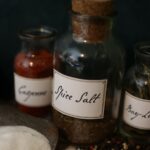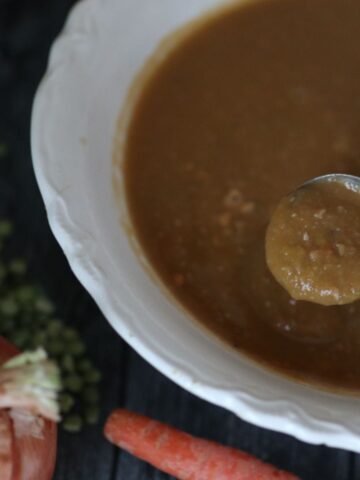A company-worthy beef soup, heartily flavored with warming spices, and the sweetness of onions and wine.

It’s an interesting thing, cooking through all these 1800’s cookbooks. Some were written for lower income families, while others were geared toward those of more means.
As I bounce back and forth between them, it’s impossible not to be struck by the sharp contrast between “economy” cooking, and richer fare. A few weeks ago, we learned to stretch a cup of lentils and a handful of vegetables into two quarts of main-dish soup, meant to feed a whole family.

Today, we’re creating a starter-course beef soup that calls for a pound of meat to every quart of water. And oh, the lovely spices that are lavished on this soup!
Both soups were meant to be made with time and care. And somehow, of all the foods we’ve made so far, it’s these soup recipes that are staying with me…making tangible the broad spectrum of what it meant to put good food on the table, in the 1800’s.

Today’s soup takes time, and it’s not economy food, by any stretch. But it is absolute heaven, and the sort of soup anyone would be proud to set in front of a guest. The warmth of the cloves, mace, and allspice…the sweetness of the onions and wine. Just perfection.
If you only ever try a handful of these recipes, I’d suggest this as one for the “must-try list”. It’s lovely.
Here’s a photo of the recipe as it appears in the cookbook:

A FEW COOKING NOTES:
What cut of beef to use
Any inexpensive, lean cut of beef would work well here. If you use a cut that’s not fairly lean, you’ll want to trim the fat, or there will be rather a lot of fat to skim from the soup as it boils (and boils, and boils).
Does it really need to boil for three hours?
It does. I actually found that mine needed about an extra half hour, for the beef to really be falling to bits. This is not a soup you can rush.

Also, don’t skip caramelizing those onions before adding them. The brown sweetness of the pre-caramelized onions really is part of the magic in this simple, but SO flavorful soup.
What to do with the strained-off bits of beef and onion?
Once the soup is strained, you’re left with a pile of heavenly-smelling beef and onion “mush”. It’s not a huge pile, but enough to really do something with. I saved mine to use for the filling in individual little pot pies–something I think it’s going to be perfect for.

What would they have done with this in the 1800’s?
Please know that I am speculating here, but my hunch is that it’s likely these beef and onion leavings may have been used toward making a dish to furnish the servant’s table, if this soup were made for a family of means.

If, however, it was made as a special occasion soup by a housewife, I expect she would probably have used it similarly to other “leftover beef” recipes. For example, “beef hash”, which sometimes was formed into patties, dipped in egg and bread crumbs, and fried. Or, similar to what I’m doing, in a leftover meat pie.
About that sherry…
Keep in mind that our “sherry cooking wine” of today has added sodium and preservatives to make it shelf stable. It absolutely can help give the depth of flavor that really takes this recipe over the top, and can be used in the same proportion as the wine in the recipe–but don’t salt the soup to taste until after you’ve added it.

Need a non-alcoholic substitute? There are lots of recommended substitutes for sherry, but I think that in this recipe I’d probably try using about an once of good apple cider vinegar, or red wine vinegar.
How much wine is “a glass”?
Over the course of the 1800’s, the size of “a glass of wine” slowly increased from about 3.4 ounces, to about 5.4 ounces. There are many interesting articles that mention this shift, but this is one of my favoritesif you’d like to read more. I felt that using 4 ounces was a pretty safe bet here, and would use the same amount again.
📖 Recipe

Beef Soup (brown)
Common Sense in the Household, 1877
A company-worthy beef soup, heartily flavored with warming spices, and the sweetness of onions and wine.
Ingredients
- 3 lbs. beef cut into strips
- 3 onions
- 3qts. water
- 1 teaspoon cloves
- ½ teaspoon pepper
- ½ teaspoon mace
- ⅛ teaspoon allspice (1 pinch)
- 1.5 cups celery
- ½ teaspoon marjoram or savory
- 1 teaspoon Worcestershire sauce
- salt to taste
- 4 ounces brown sherry or madeira
Instructions
- Put beef and water into the saucepan and boil for one hour.
- Meanwhile, slice the onions and fry them in butter to a light brown.
- Drop into the pot with a teaspoonful of cloves, half as much pepper, same quantity of mace as pepper, a pinch of allspice, and a teaspoonful of essence of celery, if you cannot get a head of fresh celery; also half a teaspoonful of powdered savory or sweet marjoram, and a teaspoonful of Worcestershire sauce.
- Stew all for two hours more, or until the beef has boiled to pieces.
- Strain the soup and return to the fire.
- Salt to taste, and just before taking it off, pour in a glass of brown sherry or Madeira wine.















Comments
No Comments